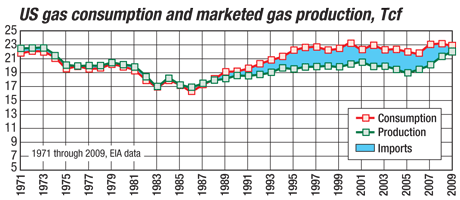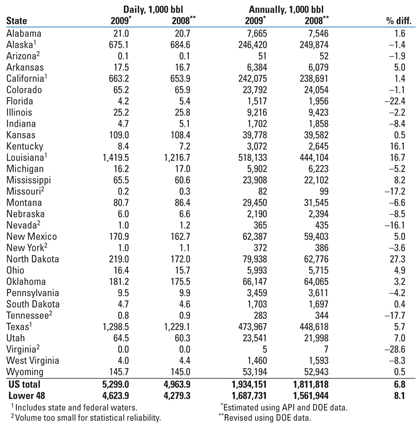US oil output sees biggest jump since Eisenhower administration
U.S Production
Crude and condensate. The long decline in US oil output over the last three decades saw a dramatic change in direction in 2009, as crude and condensate production shot up nearly 7% to an average of just under 5.3 million bpd, from a little less than 5.0 million bpd in 2008. According to historical data from the US Energy Information Administration (EIA), this is the first increase in US production since 1991, and the first increase of more than 1% since 1984. It is also the biggest percentage increase since 1955. The vast majority of this new oil output comes from three sources: increased production onshore Texas, especially in the Permian Basin, new Gulf of Mexico output that came online in 2009, and ramped-up activity in the Bakken Shale oil play of North Dakota and Montana. In fact, North Dakota, Louisiana and Texas (the latter two including state and federal GOM waters) had over 116.5 million bbl more production last year than in 2008, accounting for 95% of the total US increase. The Bakken is a continuous oil resource that represents low risk and high returns for operators, thanks to the same horizontal drilling and hydraulic fracturing technologies that are being used in the North American gas shale plays. According to the North Dakota Department of Mineral Resources, operators in that state expect to increase their output again in 2010, by about 50%. In the GOM, the projects that came online last year represent long-term investments that are not as sensitive to short-term price changes as onshore wells are. They include Shenzi, at 120,000 bpd; Tahiti, at 135,000 bpd; and Thunder Hawk, at 60,000 bpd.
Natural gas. Total US marketed natural gas production increased by 3.7% in 2009 to over 22 Tcf, continuing to close the gap between output and demand, which fell 1.5%. This is in line with an EIA forecast last year that said the US will be nearly gas independent by 2030. The increases are primarily related to unconventional gas activity in the major US shale plays. The shale plays have been so successful that Russia’s Gazprom and its partners announced in early January that they will delay plans to develop the giant Shtokman Field in the Barents Sea—with expected first-phase output of 2.3 Bcfd—for at least three years, largely because of the fall in demand for foreign gas in the US.
|
||||||||||||||||||
- What's new in production (February 2024)
- Prices and governmental policies combine to stymie Canadian upstream growth (February 2024)
- U.S. operators reduce activity as crude prices plunge (February 2024)
- U.S. producing gas wells increase despite low prices (February 2024)
- U.S. drilling: More of the same expected (February 2024)
- U.S. oil and natural gas production hits record highs (February 2024)




